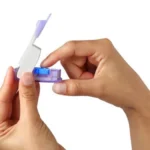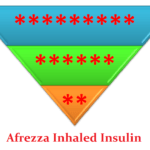Soliqua is a diabetes medication. It is a combination of Insulin Glargine and Lixisenatide, available as a pre-filled syringe. Each prefilled syringe contains 3 ml of the combination medication that contains:
- Insulin Glargine 300 units per pen or per 3 ml (this is equivalent to 100 units per ml, hence the name Soliqua 100/33), and
- Lixisenatide 99 units per pen or per 3 ml (this is equivalent to 33 units per ml, hence the name Soliqua 100/33)
What is Soliqua? Soliqua MOA (Mechanism of action)
Soliqua 100/300 pen contains two very potent diabetes medications, Insulin Glargine and Lixisenatide. It is available as a prefilled pen that contains a combination of these two drugs in a ratio of 3:1.
What is Insulin Glargine? Insulin Glargin MOA?
Insulin Glargine is a long-acting insulin. It is also available in pre-filled pens alone (without other combinations) by the brand names of Insulin Lantus and Toujeo.
Lantus and Toujeo are both Insulin Glargine, however, their concentrations are different. Insulin Toujeo is three times more concentrated than Insulin Glargine. It is also called Insulin Glargine U-300.
Insulin Glargine is basal insulin. It is a long-acting insulin, like Insulin Degludec and Insulin Levemir. It lowers blood glucose steadily and does not have a peak. After administration, its concentration in the body remains the same throughout.
Thus, it is less likely to cause hypoglycemia. However, it does not lower post meals blood glucose as effectively as short-acting insulin (human regular insulin), Rapid-acting insulin (Insulin Aspart, Insulin Glulisine, and Insulin Lispro), or Ultra-short-acting Insulin (Insulin Lyumjev, Insulin FiAsp, or Inhaled Insulin Afrezza).
Like all other Insulin, it lowers blood glucose by increasing the synthesis of glycogen from glucose, which is then stored in the liver.
It also induced the entry of glucose into the muscles and fat cells for storage and utilization. It is an anabolic hormone and causes the entry of proteins into the cells, which are the building blocks of the muscles.
What is Lixisenatide? How does it lower blood glucose?
- Lixisenatide is a selective GLP-1 receptor activator. It binds to the GLP-1 receptors and exerts its antidiabetic effects via the following mechanisms:
- It enhances the release of insulin in a glucose-dependent manner
- It slows gastric emptying, slowing the absorption of food, and ultimately, minimizing the sudden increase in blood sugars.
- It also acts on the hunger receptors present in the brain, reducing the cravings for food, especially foods with a high glycemic index.
- It also induces nausea and fullness of the stomach, which results in early satiet,y and a person ingests less food.
- Lixisenatide can be administered with metformin, insulin, or sulfonylureas to optimize blood glucose. It is also available in combination with insulin glargine by the brand name Soliqua.
When should you start Soliqua 100/33 treatment?
Soliqua 100/33 pen contains the commonly used basal insulin, insulin glargine, and the selective GLP-1 agonist, Lixisenatide. Before considering treatment with Soliqua 100/33, it is important to know should avoid using it.
The following group of patients should not consider Soliqua 100/33 treatment:
- All patients who have Diabetes Mellitus Type 1 and pregnant females.
- All patients who are allergic to either Insulin Glargine, Lixisenatide, or any component of the drug formulation
- Patients who have advanced kidney disease (with an estimated GFR of less than 15 ml/minute), advanced liver disease (Child Class C), and symptomatic heart failure with an ejection fraction of less than 25 – 30%.
- All patients with a history of recurrent pancreatitis, MEN (multiple endocrine neoplasia) syndromes, or a personal or family history of medullary thyroid carcinoma.
- In acute settings, such as patients who have diabetic ketoacidosis (DKA), Hyperosmolar Hyperglycemic State (HHS), or patients undergoing any surgical procedure.
Soliqua 100/33 (Insulin Glargine and Lixisenatide) treatment can be initiated in all patients who have not achieved good glycemic control despite exercise, diet, and one or more anti-diabetic treatments.
It may be especially preferred in patients who are using insulin Glargine Injection and Lixisenatide Injection separately for glycemic control.
Soliqua 100/33 treatment avoids an extra needle prick. Patients may be more compliant with Soliqua than with individual treatments.
It is also beneficial in patients who are on insulin glargine and have gained weight or are obese at baseline. Lixisenatide treatment in combination with Glargine does not induce weight.
Soliqua Dosing Guide and Dosing Titration Guide:
When starting Soliqua treatment, discontinue the following Diabetes Medications:
GLP-1 analogs:
These include Liraglutide (Saxenda), Dulaglutide (Trulicity), Semaglutide (Rybelsus, Ozempic, or Wegovy), and Exenatide (Byetta).
DPP-IV inhibitors (Di-Peptidyl Peptidase IV inhibitors):
These include Sitagliptin (Januvia), Vildagliptin (Galvus), Linagliptin (Tajenta or Tradjenta), and Saxagliptin (Onglyza).
Basal Insulin:
These may include Glargine Insulin (including Glargine U-100, Glargine U-300, and Glargine U-500), Detemir (Levemir), Degludec (Tresiba), and Icodec.
- A combination of medications that includes any of the above drugs.
Initial Soliqua Dosing Guide:
Patients who are not using basal insulin and a GLP-1 analog or patients who are on basal insulin treatment using 30 units or less, or using GLP-1 analog alone:
- These patients may be initiated on a dose of 15 units of daily Soliqua 100/33. This is equivalent to 15 units of Insulin glargine and 5 mcg of Lixisenatide.
Patients who are on prior basal insulin treatment of 30 to 60 units per day with or without a GLP-1 analog:
- These patients should be initiated on 30 units of Soliqua, which is equivalent to 30 units of Insulin Glargine and 10 mcg of Lixisenatide.
Soliqua Dose Titration:
- Soliqua dose titration is recommended if the blood sugars are not controlled. The dose can be titrated upwards if the patient has high blood glucose levels and reduced if hypoglycemia is documented.
- The dose is adjusted by 2 to 4 units every week until the maximum daily dose of 60 units of Soliqua is reached.
- 60 units of Soliqua contains 60 units of Insulin Glargine and 20 mcg of Lixisenatide.
Soliqua Maximum Daily Dose:
- The maximum daily dose of Soliqua should not exceed 60 units. This is equivalent to 60 units of insulin Glargine and 20 mcg of Lixisenatide.
What should you do in case you miss a Soliqua Dose?
- In case the Soliqua dose is missed, doubling the dose is not recommended. Double dosing should be avoided. The patient should be advised to take the next dose at the scheduled time.
Soliqua Dosing Titration Table:
Soliqua Low Dose:
Soliqua’s Low dose is considered between 15 and 30 units. A low dose is recommended in patients with relatively good glycemic control.
These patients are less likely to have adverse drug-related side effects such as nausea, vomiting, post-meal fullness, and pancreatitis.
Low-dose Soliqua titration is given in the table below:
Soliqua 100/33 Dose | Insulin Glargine dose | Lixisenatide dose |
| 15 | 15 units | 5 mcg |
| 16 | 16 units | 5.3 mcg |
| 17 | 17 units | 5.7 mcg |
| 18 | 18 units | 6 mcg |
| 19 | 19 units | 6.3 mcg |
| 20 | 20 units | 6.7 mcg |
| 21 | 21 units | 7 mcg |
| 22 | 22 units | 7.3 mcg |
| 23 | 23 units | 7.7 mcg |
| 24 | 24 units | 8 mcg |
| 25 | 25 units | 8.3 mcg |
| 26 | 26 units | 8.7 mcg |
| 27 | 27 units | 9 mcg |
| 28 | 28 units | 9.3 mcg |
| 29 | 29 units | 9.7 mcg |
| 30 | 30 units | 10 mcg |
Soliqua Medium Dose Titration:
Soliqua medium dose is considered when the dose ranges between 31 and 45 units. These patients are either on 30 units or more units of basal insulin before initiating treatment with Soliqua or have a moderately abnormal glycemic record.
These patients may observe some of the side effects of Soliqua such as nausea, vomiting, early satiety, weight loss, and can develop pancreatitis.
Soliqua medium-dose titration table is given below:
Soliqua 100/33 Dose | Insulin Glargine Dose | Lixisenatide Dose |
| 31 | 31 units | 10.3 mcg |
| 32 | 32 units | 10.7 mcg |
| 33 | 33 units | 11 mcg |
| 34 | 34 units | 11.3 mcg |
| 35 | 35 units | 11.7 mcg |
| 36 | 36 units | 12 mcg |
| 37 | 37 units | 12.3 mcg |
| 38 | 38 units | 12.7 mcg |
| 39 | 39 units | 13 mcg |
| 40 | 40 units | 13.3 mcg |
| 41 | 41 units | 13.7 mcg |
| 42 | 42 units | 14 mcg |
| 43 | 43 units | 14.3 mcg |
| 44 | 44 units | 14.7 mcg |
| 45 | 45 units | 15 mcg |
Soliqua High Dose:
A high dose of Soliqua is recommended in patients who have poorly controlled diabetes and those who are already on high doses of basal insulin.
Such patients may develop severe adverse drug reactions. The maximum dose of Soliqua should not exceed 60 units.
Soliqua High-dose Titration is given below:
Soliqua 100/33 Dose | Insulin Glargine Dose | Lixisenatide Dose |
| 46 | 46 units | 15.3 mcg |
| 47 | 47 units | 15.7 mcg |
| 48 | 48 units | 16 mcg |
| 49 | 49 units | 16.3 mcg |
| 50 | 50 units | 16.7 mcg |
| 51 | 51 units | 17 mcg |
| 52 | 52 units | 17.3 mcg |
| 53 | 53 units | 17.7 mcg |
| 54 | 54 units | 18 mcg |
| 55 | 55 units | 18.3 mcg |
| 56 | 56 units | 18.7 mcg |
| 57 | 57 units | 19 mcg |
| 58 | 58 units | 19.3 mcg |
| 59 | 59 units | 19.7 mcg |
| 60 | 60 units | 20 mcg |
Patients who are on a maximum dose of Soliqua and still have poorly controlled Diabetes should be switched to another regimen.
These regimens may include:
- Twice daily Premixed Insulins with metformin, sitagliptin, or an SGLT2 Inhibitor (Jardiance or Farxiga)
- Basal Bolus regimen containing long-acting insulin at night and premeal bolus insulin such as Insulin Aspart, Glulisine, Lispro, Lyumjev, FiAsp, Afrezza, or human Regular Insulin.
- Adding SGLT2 inhibitor (Jardiance or Farxiga) to Soliqua and metformin.
TitleThumbnailPrice$49.99$89.99$9.90More informationTitleThumbnailPrice$49.99More informationTitleThumbnailPrice$89.99More informationTitleThumbnailPrice$9.90More information







